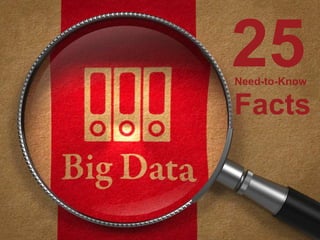
Big Data - 25 Amazing Facts Everyone Should Know
- 1. BIG Data 25 Need-to-Know Facts
- 2. Every 2 days we create as much information as we did from the beginning of time until 2003. Source 1
- 3. Over 90% of all the data in the world was created in the past 2 years. Source 2
- 4. It is expected that by 2020 the amount of digital information in existence will have grown from 3.2 zettabytes today to 40 zettabytes. Source 3
- 5. The total amount of data being captured and stored by industry doubles every 1.2 years. Source 4
- 6. Every minute we send 204 million emails, generate 1,8 million Facebook likes, send 278 thousand Tweets, and up-load 200,000 photos to Facebook. Source 5
- 7. Google alone processes on average over 40 thousand search queries per second, making it over 3.5 billion in a single day. Source 6
- 8. Around 100 hours of video are uploaded to YouTube every minute and it would take you around 15 years to watch every video uploaded by users in one day. Source 7
- 9. Around 100 hours of video are uploaded to YouTube every minute and it would take you around 15 years to watch every video uploaded by users in one day. Source 8
- 10. If you burned all of the data created in just one day onto DVDs, you could stack them on top of each other and reach the moon – twice. Source 9
- 11. AT&T is thought to hold the world’s largest volume of data in one unique database – its phone records database is 312 terabytes in size, and contains almost 2 trillion rows. Source 10
- 12. 570 new websites spring into existence every minute of every day. Source 11
- 13. 1.9 million IT jobs will be created in the US by 2015 to carry out big data projects. Each of those will be supported by 3 new jobs created outside of IT – meaning a total of 6 million new jobs thanks to big data. Source 12
- 14. 13 Today’s data centres occupy an area of land equal in size to almost 6,000 football fields. Source
- 15. 14Between them, companies monitoring Twitter to measure “sentiment” analyze 12 terabytes of tweets every day. Source
- 16. The amount of data transferred over mobile networks increased by 81% to 1.5 exabytes (1.5 billion gigabytes) per month between 2012 and 2014. Video accounts for 53% of that total. Source 15
- 17. The NSA is thought to analyze 1.6% of all global internet traffic – around 30 petabytes (30 million gigabytes) every day. Source 16
- 18. The value of the Hadoop market is expected to soar from $2 billion in 2013 to $50 billion by 2020, according to market research firm Allied Market Research. Source 17
- 19. The number of Bits of information stored in the digital universe is thought to have exceeded the number of stars in the physical universe in 2007. Source 18
- 20. This year, there will be over 1.2 billion smart phones in the world (which are stuffed full of sensors and data collection features), and the growth is predicted to continue. Source 19
- 21. The boom of the Internet of Things will mean that the amount of devices connected to the Internet will rise from about 13 billion today to 50 billion by 2020. Source 20
- 22. 12 million RFID tags – used to capture data and track movement of objects in the physical world – had been sold in by 2011. By 2021, it is estimated that number will have risen to 209 billion as the Internet of Things takes off. Source 21
- 23. Big data has been used to predict crimes before they happen – a “predictive policing” trial in California was able to identify areas where crime will occur three times more accurately than existing methods of forecasting. Source 22
- 24. By better integrating big data analytics into healthcare, the industry could save $300bn a year – that’s the equivalent of reducing the healthcare costs of every man, woman and child by $1,000 a year. Source 23
- 25. Retailers could increase their profit margins by more than 60% through the full exploitation of big data analytics. Source 24
- 26. The big data industry is expected to grow from US$10.2 billion in 2013 to about US$54.3 billion by 2017. Source 25
